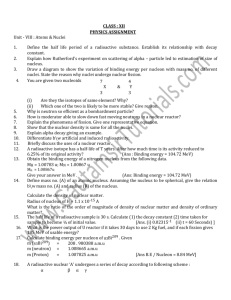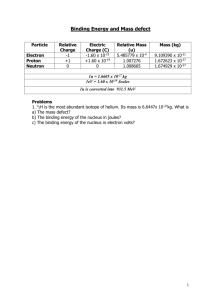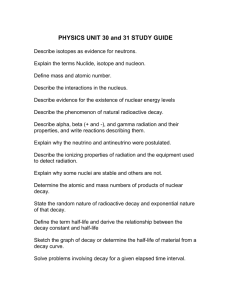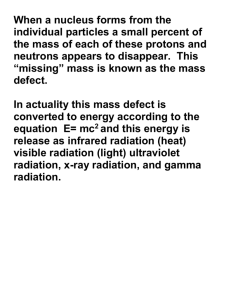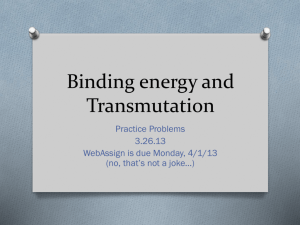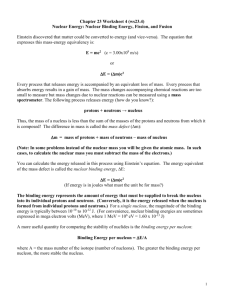File - SPHS Devil Physics
advertisement
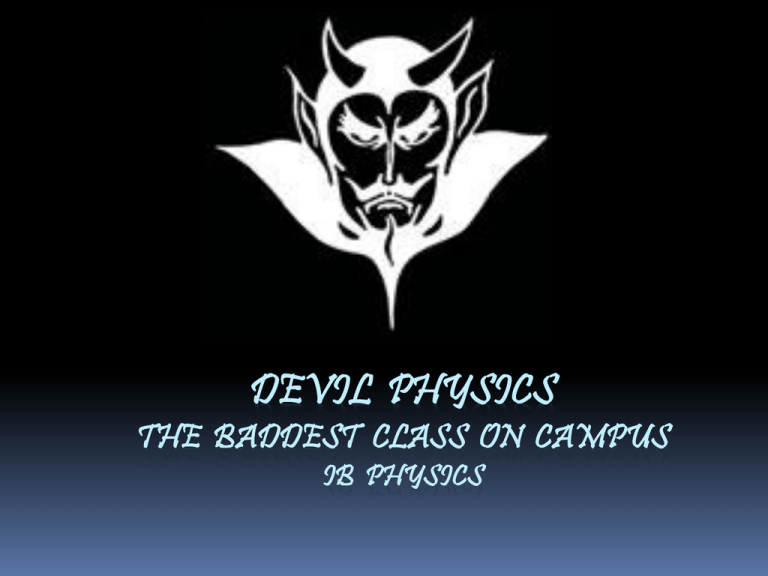
DEVIL PHYSICS THE BADDEST CLASS ON CAMPUS IB PHYSICS TSOKOS LESSON 7-2 NUCLEAR REACTIONS Review Videos-Radioactivity2 Review Videos - Strong and Weak Nuclear Forces Essential Idea: Energy can be released in nuclear decays and reactions as a result of the relationship between mass and energy. Nature Of Science: Patterns, trends and discrepancies: Graphs of binding energy per nucleon and of neutron number versus proton number reveal unmistakable patterns. This allows scientists to make predictions of isotope characteristics based on these graphs. Theory Of Knowledge: The acceptance that mass and energy are equivalent was a major paradigm shift in physics. How have other paradigm shifts changed the direction of science? Have there been similar paradigm shifts in other areas of knowledge? Understandings: The unified atomic mass unit Mass defect and nuclear binding energy Nuclear fission and nuclear fusion Applications And Skills: Solving problems involving mass defect and binding energy Solving problems involving the energy released in radioactive decay, nuclear fission and nuclear fusion Applications And Skills: Sketching and interpreting the general shape of the curve of average binding energy per nucleon against nucleon number Guidance: Students must be able to calculate changes in terms of mass or binding energy Binding energy may be defined in terms of energy required to completely separate the nucleons or the energy released when a nucleus is formed from its nucleons Data Booklet Reference: E m c 2 Utilization: Our understanding of the energetics of the nucleus has led to ways to produce electricity from nuclei but also to the development of very destructive weapons The chemistry of nuclear reactions (see Chemistry option sub-topics C.3 and C.7) Aims: Aim 5: some of the issues raised by the use of nuclear power transcend national boundaries and require the collaboration of scientists from many different nations Aims: Aim 8: the development of nuclear power and nuclear weapons raises very serious moral and ethical questions: who should be allowed to possess nuclear power and nuclear weapons? who should make these decisions? There also serious environmental issues associated with the nuclear waste of nuclear power plants. Define the unified mass unit (u) Equal to 1/12 of the mass of a Carbon-12 atom Mass of a mole of Carbon-12 is 12g Avogadro's number gives atoms per mole Therefore the mass of a Carbon-12 atom is 12 3 M x10 kg 23 6.02 x10 26 M 1.99 x10 kg Define the unified mass unit (u) Equal to 1/12 of the mass of a Carbon-12 atom So 1 atomic mass unit is: 1 26 27 1u x1.99 x10 kg 1.66 x10 kg 12 27 1u 1.6605402 x10 kg Define the unified mass unit (u) Find the mass of an electron, proton and neutron in amu’s Define the unified mass unit (u) Find the mass of an electron, proton and neutron in amu’s Electron: 0.0005486 u Proton: 1.007276 u Neutron: 1.008665 u State the meaning of the terms mass defect and binding energy and solve related problems The mass of the nucleus is equal to the atomic mass minus the mass of the electrons: M nucleus M atom Zmelectron The atomic mass is given by the periodic table and the electron mass is given in the previous table State the meaning of the terms mass defect and binding energy and solve related problems The mass of a helium nucleus would thus be: M nucleus 4.0026 2 x0.0005486 M nucleus 4.00156u However, if we add the masses of the individual nucleons we get: 2m p 2mn 4.0320u What’s up with that? State the meaning of the terms mass defect and binding energy and solve related problems The mass of the protons plus the mass of the neutrons is larger than the atomic mass The difference between the two is called the mass defect Zm p A Z mn M nucleus State the meaning of the terms mass defect and binding energy and solve related problems Find the mass defect of a gold nucleus in amu’s if the atomic mass given on the periodic table is 196.967 u 197 79 Au State the meaning of the terms mass defect and binding energy and solve related problems Find the mass defect of a gold nucleus in amu’s if the atomic mass given on the periodic table is 196.967 u 197 79 Au Zm p A Z mn M nucleus Zm p 791.6726231x10 27 1.6605402 x10 27 A Z mn 197 791.6749286 x1027 1.6605402 x1027 M nucleus 196.967u 799.1093897 31 1.6605402 x10 27 State the meaning of the terms mass defect and binding energy and solve related problems Find the mass defect of a gold nucleus in amu’s if the atomic mass given on the periodic table is 196.967 u 197 79 Au Zm p A Z mn M nucleus Zm p 79.5748u A Z mn 119.022u M nucleus 196.924u 79.5748u 119.022u 196.924u 1.6728u State the meaning of the terms mass defect and binding energy and solve related problems Find the mass defect of a gold nucleus if the atomic mass given on the periodic table is 196.967 u 197 79 Au Answer: 1.67 u which is the equivalent of 1.7 neutrons State the meaning of the terms mass defect and binding energy and solve related problems Einstein’s mass-energy formula What happened to the missing mass? Einstein said, “No worries, it’s all relative.” E mc 2 His theory of special relativity states that mass and energy are equivalent and can be converted into each other. Throw a match into a bucket of gasoline and note the conversion of mass into energy BUT, this reaction is not reversible! State the meaning of the terms mass defect and binding energy and solve related problems Einstein’s mass-energy formula Conversion of energy into mass is not as common, but explains why photons have momentum The mass defect of the nucleus has been converted into energy – binding energy (Eb) – and is stored in the nucleus Eb c 2 State the meaning of the terms mass defect and binding energy and solve related problems Binding Energy Eb c 2 The binding energy of a nucleus is the work (energy) required to completely separate the nucleons of a nucleus The work required to remove one nucleon from the nucleus is very roughly the binding energy divided by the number of nucleons More importantly, the binding energy of a nucleus is a measure of how stable it is – higher the binding energy, the more stable the nucleus is Segre Plots At low Z numbers, stable nuclides have N = Z At higher Z numbers, N>Z Segre Plots Most nuclides are unstable Unstable nuclides emit particles that carry energy away from the nucleus This is called radioactivity State the meaning of the terms mass defect and binding energy and solve related problems How much binding energy is there in 1u of mass defect? Eb c 2 1 26 27 1u x1.99 x10 kg 1.66 x10 kg 12 State the meaning of the terms mass defect and binding energy and solve related problems How much binding energy is there in 1u of mass defect? Eb c 2 Eb m c 2 Eb 1.66 x10 Eb 1.49 x10 27 10 kg 3.00 x10 m / s J 8 2 State the meaning of the terms mass defect and binding energy and solve related problems How much binding energy is there in 1u of mass defect? 10 Eb 1.49 x10 J Converting this to electronvolts: 1eV Eb 1.49 x10 J 19 1.60 x10 J Eb 931.5 x106 eV 931.5MeV 10 State the meaning of the terms mass defect and binding energy and solve related problems This gives us an important relationship – the binding energy per unit of mass defect Eb u 931.5MeV What is the binding energy of a helium nucleus? State the meaning of the terms mass defect and binding energy and solve related problems What is the binding energy of a helium nucleus? Recall that the mass defect of helium is 0.0304u Eb 931.5MeV u 0.0304x931.5MeV 28.32MeV This is extremely high and explains why alpha particles are emitted when unstable nuclei decay State the meaning of the terms mass defect and binding energy and solve related problems What is the binding energy per nucleon of a helium nucleus? Eb 28.32MeV 4 7.1MeV Most nuclei have a binding energy per nucleon of approximately 7-9 MeV The following chart shows binding energy per nucleon vs. number of nucleons Understand the meaning of the graph of binding energy per nucleon versus mass number Understand the meaning of the graph of binding energy per nucleon versus mass number Understand the meaning of the graph of binding energy per nucleon versus mass number Energy released in a decay Consider this decay of radium into radon plus an alpha particle: 226 88 Ra Rn 222 86 4 2 The mass/energy to the left of the arrow must equal the mass/energy to the right of the arrow – including kinetic energy Energy released in a decay Consider this decay of radium into radon plus an alpha particle: 226 88 Ra Rn 222 86 4 2 Energy is based on nuclear mass, not atomic mass, but since the atomic number is conserved here (no loss of electrons) and since we are only interested in mass differences, we can use atomic mass i.e. electron mass will cancel out and not affect the mass difference Energy released in a decay Consider this decay of radium into radon plus an alpha particle: 226 88 Ra Rn 222 86 4 2 If energy is to be released in this reaction, the mass of the radium atom must be greater than the mass of the radon atom plus the mass of the alpha particle Difference in masses provides kinetic energy Assume the radium atom is at rest Energy released in a decay Consider this decay of radium into radon plus an alpha particle: 226 88 Ra Rn 222 86 4 2 Mass of radium = 226.0254 u 222.0176 u 4.0026 u 226.0202 u 0.0052 u Mass of radon = + Mass of helium = Sum = Mass difference = Energy released in a decay Consider this decay of radium into radon plus an alpha particle: 226 88 Ra Rn 222 86 4 2 Mass difference = 0.0052 u The energy released in this decay is 0.0052x931.5MeV 4.84MeV Energy released in a decay Consider this decay of radium into radon plus an alpha particle: 226 88 Ra Rn 222 86 4 2 The energy released in one decay is 4.84 MeV What is the energy release by 50-g of radium? 1mol 6 x1023 atoms 1.3x1023 atoms 50 g x x mol 226 g 1.3x1023 atomsx4.84MeV 6.3x1023 MeV 6.3x1023 MeVx 1.6 x1019 J eV 1x1011 J Energy released in a decay Consider this decay of radium into radon plus an alpha particle: 226 88 Ra Rn 222 86 4 2 The energy released in one decay is 4.84 MeV What is the energy release by 50-g of radium? 1mol 6 x1023 atoms 1.3x1023 atoms 50 g x x mol 226 g 1.3x1023 atomsx4.84MeV 6.3x1023 MeV 6.3x1023 MeVx 1.6 x1019 J eV 1x1011 J Energy released in a decay Consider this decay of radium into radon plus an alpha particle: 226 88 Ra Rn 222 86 4 2 What happens to the energy released by 50-g of radium? Use conservation of momentum and assume they go in opposite directions. mradonvradon malphavalpha mradon vradon valpha malpha 222 vradon valpha 4 55vradon valpha Energy released in a decay Consider this decay of radium into radon plus an alpha particle: 226 88 Ra Rn 222 86 4 2 Write nuclear reaction equations and balance the atomic and mass numbers Consider a reaction in which the mass on the left side is less than the mass on the right side. Can this occur? Write nuclear reaction equations and balance the atomic and mass numbers Consider a reaction in which the mass on the left side is less than the mass on the right side. Can this occur? Yes. Consider: 14 7 N O p 4 2 17 8 1 1 While the atomic numbers and mass numbers are balanced, the masses are not. The sum of the nucleon masses on the left is 18.0057 while the sum on the right is 18.0070 Write nuclear reaction equations and balance the atomic and mass numbers Consider a reaction in which the mass on the left side is less than the mass on the right side. 14 4 17 1 7 N 2 8 O 1 p The mass on the left is 18.0057u The mass on the right is 18.0070u The reaction can only occur if the alpha particle has enough kinetic energy to overcome the mass difference and the kinetic energy that will result from the reaction. Write nuclear reaction equations and balance the atomic and mass numbers Reaction of 4 particles A B C D Energy release/requirements given by the mass difference: m mA mB mC mD Energy will be released if Δm is positive Energy is required if Δm is negative Write nuclear reaction equations and balance the atomic and mass numbers The amount of energy released is given by: E mc 2 Summary – Part A Define the unified mass unit State the meaning of the terms mass defect and binding energy and solve related problems Understand the meaning of the graph of binding energy per nucleon versus mass number Write nuclear reaction equations and balance the atomic and mass numbers Summary – Part B State the meaning of and difference between fission and fusion Understand that nuclear fusion takes place in the core of the stars Solve problems of fission and fusion reactions State the meaning of and difference between fission and fusion State the meaning of and difference between fission and fusion Nuclear fission is the process in which a heavy nucleus splits into lighter nuclei A typical reaction occurs when the nucleus of U235 absorbs an extra neutron to become U-236 This “triggers” the reaction by making the U-235 more unstable 1 0 n U U 235 92 236 92 State the meaning of and difference between fission and fusion 1 0 n U U 235 92 236 92 This occurs only momentarily as the atom then splits into lighter nuclei One of several possibilities is, U Ba Kr 3 n 236 92 144 56 89 36 1 0 State the meaning of and difference between fission and fusion U Ba Kr 3 n 236 92 144 56 89 36 1 0 Note that in this reaction, three neutrons are released 1 0 3 n 1 0 n U U 235 92 236 92 These three neutrons have enough energy to start three more reactions Those three start another three each and the result is a chain reaction State the meaning of and difference between fission and fusion U Ba Kr 3 n 236 92 144 56 89 36 1 0 A minimum mass is required to start a chain reaction This is known as the critical mass State the meaning of and difference between fission and fusion U Ba Kr 3 n 236 92 144 56 89 36 1 0 The energy released in this fission reaction is given below State the meaning of and difference between fission and fusion This excess energy is translated into kinetic energy Conservation of momentum and energy equations are used to determine particle velocities State the meaning of and difference between fission and fusion What is a natural by-product of increased kinetic energy of atoms? State the meaning of and difference between fission and fusion State the meaning of and difference between fission and fusion Energy released in 1kg of U-235 1000 g mol 6 x10 23 nuclei x x 1kg x mol kg 235 g 13 1.602177 x10 J 23 2.55 x10 nuclei 173.14MeV 1MeV 7.1x1013 J State the meaning of and difference between fission and fusion Energy released in 1kg of U-235 7.1 x 1013 J Energy released in 1kg of nitroglycerin 6.7 x 106 J U-235 fission is roughly 10 million times more powerful than nitroglycerine State the meaning of and difference between fission and fusion The rate of reaction in nuclear reactors must be controlled in order to prevent an explosion This is done mainly by control rods that absorb some of the neutrons given off in the reactions Also by the water surrounding the fuel rods that slow down the released neutrons State the meaning of and difference between fission and fusion Fusion is the joining of two lighter nuclei into one heavier one An example reaction is, 2 1 H H He n 2 1 3 2 1 0 Two deuterium nuclei produce helium-3 and a neutron State the meaning of and difference between fission and fusion 2 1 H H He n 2 1 3 2 1 0 The energy given off by this reaction is, State the meaning of and difference between fission and fusion 2 1 H H He n 2 1 3 2 1 0 The energy given off by one kilogram of deuterium is roughly 1x1013 J This is seven times less than the fission reaction, but when you’re talking about a 1013 order of magnitude, who’s gonna notice? State the meaning of and difference between fission and fusion Fusion requires extremely high temperatures to overcome electrostatic repulsion High temperature means high kinetic energy of atoms High kinetic energy allows them to get close enough for the strong nuclear force to take over State the meaning of and difference between fission and fusion Temperatures required (109 K) turn everything into plasma In stars, only 106 K required due to the tremendous pressure created by gravitational attraction How do you contain the reactants? State the meaning of and difference between fission and fusion Temperatures required turn everything into plasma How do you contain the reactants? Electromagnetic fields in machines called Tokamaks This is why fusion energy has not become commercially feasible in spite of all the environmental benefits Understand that nuclear fusion takes place in the core of the stars Typical reaction: Fusion is the energy engine for stars Stars exist in a plasma state Extremely high temperatures Extremely high pressures 4 H He 2 e 2 e 1 1 4 2 0 1 0 0 Fission OR Fusion??? Recall the binding energy per nucleon plot: Understand that nuclear fusion takes place in the core of the stars Stars are also element factories producing all of the elements contained in our bodies More on this in astrophysics (optional) Summary – Part A Define the unified mass unit State the meaning of the terms mass defect and binding energy and solve related problems Understand the meaning of the graph of binding energy per nucleon versus mass number Write nuclear reaction equations and balance the atomic and mass numbers Summary – Part B State the meaning of and difference between fission and fusion Understand that nuclear fusion takes place in the core of the stars Solve problems of fission and fusion reactions Understandings: The unified atomic mass unit Mass defect and nuclear binding energy Nuclear fission and nuclear fusion Applications And Skills: Solving problems involving mass defect and binding energy Solving problems involving the energy released in radioactive decay, nuclear fission and nuclear fusion Applications And Skills: Sketching and interpreting the general shape of the curve of average binding energy per nucleon against nucleon number Guidance: Students must be able to calculate changes in terms of mass or binding energy Binding energy may be defined in terms of energy required to completely separate the nucleons or the energy released when a nucleus is formed from its nucleons Data Booklet Reference: E m c 2 Essential Idea: Energy can be released in nuclear decays and reactions as a result of the relationship between mass and energy. QUESTIONS? Homework #16-

